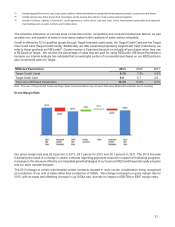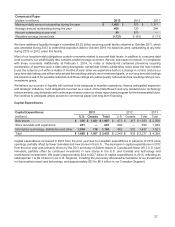Target 2013 Annual Report Download - page 36
Download and view the complete annual report
Please find page 36 of the 2013 Target annual report below. You can navigate through the pages in the report by either clicking on the pages listed below, or by using the keyword search tool below to find specific information within the annual report.31
losses. We are also unable to estimate a range of reasonably possible losses arising from Data Breach-related
litigation and governmental investigations. See Item 7, Management’s Discussion and Analysis of Financial
Condition and Results of Operations and Note 17 of the Notes to the Consolidated Financial Statements included in
Item 8, Financial Statements and Supplementary Data for further information on the Data Breach-related
contingencies.
New Accounting Pronouncements
We do not expect that any recently issued accounting pronouncements will have a material effect on our financial
statements.
Forward-Looking Statements
This report contains forward-looking statements, which are based on our current assumptions and expectations. These
statements are typically accompanied by the words "expect," "may," "could," "believe," "would," "might," "anticipates,"
or words of similar import. The principal forward-looking statements in this report include: our financial performance,
statements regarding the adequacy of and costs associated with our sources of liquidity, the fair value and amount of
the beneficial interest asset, the continued execution of our share repurchase program, our expected capital
expenditures, the impact of changes in the expected effective income tax rate on net income, the expected compliance
with debt covenants, the expected impact of new accounting pronouncements, our intentions regarding future dividends,
contributions and payments related to our pension and postretirement health care plans, the expected returns on
pension plan assets, the effects of macroeconomic conditions, the adequacy of our reserves for general liability, workers'
compensation and property loss, the expected outcome of, and adequacy of our reserves for, investigations, inquiries,
claims and litigation, including those related to the Data Breach, expected insurance recoveries, expected changes
to our contractual obligations, the expected ability to recognize deferred tax assets and liabilities, including foreign net
operating loss carryforwards, and the resolution of tax matters.
All such forward-looking statements are intended to enjoy the protection of the safe harbor for forward-looking
statements contained in the Private Securities Litigation Reform Act of 1995, as amended. Although we believe there
is a reasonable basis for the forward-looking statements, our actual results could be materially different. The most
important factors which could cause our actual results to differ from our forward-looking statements are set forth on
our description of risk factors in Item 1A to this Form 10-K, which should be read in conjunction with the forward-looking
statements in this report. Forward-looking statements speak only as of the date they are made, and we do not undertake
any obligation to update any forward-looking statement.
Item 7A. Quantitative and Qualitative Disclosures About Market Risk
At February 1, 2014, our exposure to market risk was primarily from interest rate changes on our debt obligations,
some of which are at a LIBOR-plus floating-rate. Our interest rate exposure is primarily due to the extent by which our
floating rate debt obligations differ from our floating rate short term investments. At February 1, 2014, our floating rate
debt exceeded our floating rate short term investments by approximately $1 billion. As a result, based on our balance
sheet position at February 1, 2014, the annualized effect of a 0.1 percentage point increase in floating interest rates
on our floating rate debt obligations, net of our short-term investments, would be to decrease earnings before income
taxes by approximately $1 million. In general, we expect our floating rate debt to exceed our floating rate short-term
investments over time, but that may vary in different interest rate environments. See further description of our debt
and derivative instruments in Notes 18 and 19 of the Notes to Consolidated Financial Statements.
We record our general liability and workers' compensation liabilities at net present value; therefore, these liabilities
fluctuate with changes in interest rates. Periodically, in certain interest rate environments, we economically hedge a
portion of our exposure to these interest rate changes by entering into interest rate forward contracts that partially
mitigate the effects of interest rate changes. Based on our balance sheet position at February 1, 2014, the annualized
effect of a 0.5 percentage point decrease in interest rates would be to decrease earnings before income taxes by
$8 million.
In addition, we are exposed to market return fluctuations on our qualified defined benefit pension plans. A 0.5 percentage
point decrease to the weighted average discount rate would increase annual expense by $30 million. The value of our
pension liabilities is inversely related to changes in interest rates. To protect against declines in interest rates, we hold
high-quality, long-duration bonds and interest rate swaps in our pension plan trust. At year-end, we had hedged
50 percent of the interest rate exposure of our funded status.
























